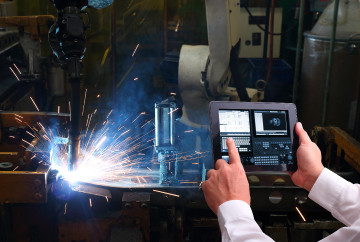How do we envision the interplay of IoT and Operations to improve plant performance, supply chain orchestration, product performance and delivery?
IoT helps to improvise operations and efficiencies. Process enhancements with smart connected products involve leveraging IoT across predictive/proactive monitoring, real-time reporting/visibility, quality checks and management as well as personalization and driving additional opportunities.
Tomorrow’s factories demand that no asset/process should be in silos. Instead, they should exist in a connected world of people, processes, systems and products, offering enhanced benefits in efficiencies and performance. Manufacturers must ready themselves for tomorrow in areas like production or asset optimization, preventative and predictive maintenance, energy management and workforce safety - all using IoT to improve plant performance via Smart Manufacturing. Enhance the Supply chain with IoT-enabled Asset/Inventory management and Logistics – inbound and outbound lead to improve visibility, tracking and resiliency. IoT-powered Connected Products to enable remote operations, preventative maintenance, product-enabled service, and efficient content/consumables delivery.
Where do we begin?
While the key ask for the manufacturers is to have an integrated view of people, processes and assets. Factories of tomorrow direct leaders to answer some of the critical questions on this journey. These include:
- What is the core business challenge that needs to be addressed?
- How will the success of the initiative be measured? What are the business outcomes that will drive the efforts?
- Are we aligned with the enterprise vision? Do we have collaboration and participation from the folks in OT and IT?
- Do we have experts with the right skill set to understand business and IT requirements?
Manufacturers must follow business strategies that help integrating IT and OT while establishing the roadmap and architecture needed to cover the gaps on the way to building intelligent factories.
How can Smart Connected operations transform enterprises in order to achieve the objectives that they set out for?
A suitable example of how enterprises are achieving their business objectives through connected operations is that of a leading Indian manufacturer of motorcycles and 3-wheelers. The company was looking for a way to deploy new technology to ensure consistency in the quality of the surface treatment processes for the parts received from their suppliers and in-house units.
They hoped to avoid recalls, failures, and customer dissatisfaction from defective parts. The client partnered with Birlasoft on a solution based on their IP, industry knowledge and ability to manage ecosystems.
Birlasoft built a solution on an IoT platform for real-time remote monitoring and control of the critical parameters of the processes at various locations and alerted users to issues.
The Solution:
Ran off-edge computing and SCADA systems, used Kepware software for industrial connectivity, covered QA for 23 processes at 2 in-house plants and 12 supplier locations and is planned to be expanded to over 85 operations across 50 locations.




